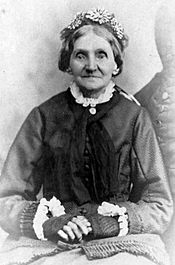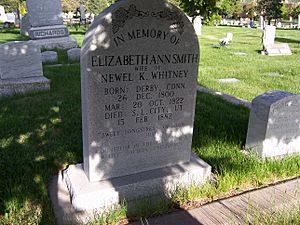Elizabeth Ann Whitney facts for kids
Quick facts for kids Elizabeth Ann Whitney |
|
|---|---|

ca. 1870
|
|
| Second Counselor in the general presidency of the Relief Society |
|
| 1866 – February 15, 1882 | |
| Called by | Eliza R. Snow |
| Predecessor | Dormant |
| Successor | Bathsheba W. Smith |
| Second Counselor in the general presidency of the Relief Society | |
| March 17, 1842 – 1844 | |
| Called by | Emma Hale Smith |
| Predecessor | Founding Member |
| Successor | Dormant |
| Personal details | |
| Born | Elizabeth Ann Smith December 26, 1800 Derby, Connecticut, United States |
| Died | February 15, 1882 (aged 81) Salt Lake City, Utah, United States |
| Resting place | Salt Lake City Cemetery 40°46′37″N 111°51′29″W / 40.777°N 111.858°W |
| Spouse(s) | Newel K. Whitney |
| Parents | Gibson Smith Polly Bradley |
Elizabeth Ann Smith Whitney (born December 26, 1800 – died February 15, 1882) was an important early leader in the Latter Day Saint movement. She was married to Newel K. Whitney, who was also a leader. She was often called Ann.
Contents
Early Life and Family
Elizabeth Ann Smith was born in Derby, Connecticut. Her parents were Gibson Smith and Polly Bradley. She was their oldest child. Her parents were not part of any church, but they believed in Christian teachings. Ann described herself as "naturally religious" when she was young.
She received a good education for her time. This included learning skills like dancing and singing. When Ann was about 18, she left home after a disagreement with her mother. She traveled west to Kirtland, Ohio with her unmarried aunt, Sarah Smith. This journey showed how independent and self-reliant they were.
Marriage and Children
In Kirtland, Ann met Newel K. Whitney. They dated for three years and then married on October 20, 1822. They became quite successful and well-known in their community. Ann and Newel had eleven children together. They also adopted several homeless children.
Joining the Church
In Kirtland, Ann and her husband joined a group called the Disciples of Christ. This group was also known as the Campbellites. They were led by Sidney Rigdon in that area. Ann and Newel felt that this group did not fully answer their questions about the Holy Spirit. Because of this, they prayed for guidance. They later said they saw a vision and heard a voice. It told them to "Prepare to receive the word of the Lord, for it is coming!"
Conversion to Latter Day Saint Faith
In 1830, Sidney Rigdon joined The Church of Jesus Christ of Latter-day Saints. This church had been started by Joseph Smith in April 1830. Ann heard about Rigdon's conversion and that missionaries were in the area. She agreed to listen to them preach. She was especially impressed that they did not ask for money.
After hearing them speak, Ann felt it was the right church. She told her husband, Newel. Parley P. Pratt then taught Ann and Newel more about the faith. They both chose to be baptized in November 1830. Sidney Rigdon performed their baptisms.
Meeting Joseph Smith
In December 1830, Joseph and Emma Smith arrived at Newel K. Whitney's store in Kirtland. Joseph greeted them by saying, "I am Joseph the Prophet; you have prayed me here; now what do you want of me?" The Smiths then stayed in their home.
While staying with the Whitneys, Joseph received important messages. These messages are now part of the Doctrine and Covenants. Ann felt that Joseph and Emma's arrival was a fulfillment of a vision she and Newel had seen earlier. In that vision, "a cloud of glory rested upon [their] house." Joseph noticed Ann's beautiful singing voice. He called her "the sweet songstress of Zion."
Ann received a special blessing from Joseph Smith Sr.. After this blessing, she sang about the history of Adam-ondi-Ahman in tongues. The blessing had mentioned her "gift of singing inspirationally." In January 1836, Ann and Newel hosted a three-day feast for people who were poor. Later, they lost some of their money when a bank failed. Church members also faced difficult times.
Moving Westward
Ann and her family traveled with other members of the church. They left Kirtland in the fall of 1838 because of persecution. They planned to move to Far West, Missouri. However, when they reached St. Louis, they learned that Latter-day Saints were being forced out of Missouri.
They settled in Carrollton, Illinois for the winter of 1838–1839. Then they moved to Quincy, Illinois the next winter. By the spring of 1840, they had reached Nauvoo, Illinois. When they arrived, most of the family was sick. Ann also gave birth to her ninth child there. In Nauvoo, Ann and Newel received special blessings and were married for eternity in the Nauvoo Temple by Joseph Smith.
Journey to Salt Lake Valley
The family continued to move with the Saints. They went to Winter Quarters in February 1846. From there, they migrated to the Salt Lake Valley. During this difficult journey, Ann developed rheumatoid arthritis in her arms and legs. She also gave birth to a son, Newel M., at Winter Quarters.
They finally arrived in Salt Lake City on September 24, 1848. Two years later, her husband, Newel, passed away.
Church Service and Leadership
In March 1842, Ann Whitney became one of the first leaders of the Relief Society. This group included Emma Hale Smith, Sarah M. Cleveland, and Eliza R. Snow. Ann served as the second counselor to Emma Smith. Ann often led the Relief Society's meetings in Nauvoo. This was because Emma Smith was often traveling, sick, or dealing with personal challenges.
After the Nauvoo temple was finished, Ann was the second woman to receive her special temple blessings. She worked there daily during the winter of 1845-46. She helped other members receive their blessings too. In 1850, Brigham Young asked her to lead the women's department of the Endowment House. Ann also served as second counselor to Eliza R. Snow in the Relief Society presidency from 1880 to 1882.
Later Years and Legacy
Starting in August 1878, Ann Whitney's life story was published. It appeared in a series called A Leaf from an Autobiography in the Woman's Exponent magazine. In November 1879, she bought a piece of land that had belonged to Brigham Young.
Death and Remembrance
Church members lovingly called Elizabeth Whitney "Mother Whitney." This was because of her service and kindness. She was known for having the gift of tongues, and she even sang in tongues. Ann Whitney also used seer stones, which were used to help find things or understand spiritual matters.
She passed away in Salt Lake City in 1882. She was buried in the Salt Lake City Cemetery. At the time of her death, she was the second oldest member of the church. Daniel H. Wells, Lorenzo D. Young, and Joseph F. Smith spoke at her funeral. They praised her strong faith and dedicated service to the church. In 1957, a residence hall at Brigham Young University was named after her.
See also
 In Spanish: Elizabeth Ann Whitney para niños
In Spanish: Elizabeth Ann Whitney para niños



